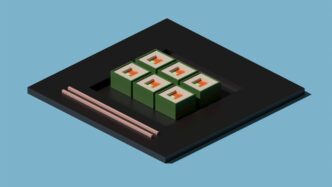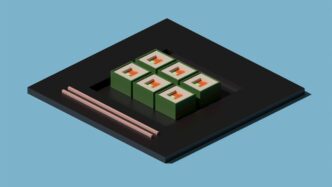For a long time, quantum computing felt like something from a sci-fi movie, always just around the corner but never quite here. But things are changing, and fast. By 2025, quantum computers are moving out of research labs and into the real world, starting to tackle problems that were impossible before. This article looks at what you can expect regarding the quantum chip price and how this technology is becoming more accessible.
Key Takeaways
- Quantum computers are already here and being used by businesses for practical tasks like scheduling and logistics, not just theoretical research.
- Major advancements in error correction and hardware are making quantum systems more reliable and powerful.
- While cloud access is common now, the goal is for more accessible, perhaps even smaller, quantum systems in the future, though home use isn’t expected soon.
- Global investment and competition are driving rapid development in quantum technology, similar to the semiconductor industry.
- By 2025, the quantum chip price is expected to become clearer as more applications emerge and the technology matures, offering a strong value proposition for specific complex problems.
The Evolving Landscape of Quantum Chip Price
From Sci-Fi to Enterprise Solutions
Quantum computing used to feel like something out of a science fiction movie, right? We’re talking about machines that could solve problems in minutes that would take today’s best supercomputers ages. For a long time, that’s pretty much where it stayed – in labs and theoretical discussions. But things are changing, and fast. Companies are starting to see real potential, not just for groundbreaking research, but for practical business applications. This shift from pure theory to potential enterprise solutions is a big reason why we’re even talking about quantum chip prices today. It’s no longer just about academic curiosity; it’s about what businesses can actually do with this technology.
Quantum Computing’s Current State
So, where are we right now? Well, quantum computers are still pretty specialized. Think of them less like your laptop and more like a highly sensitive scientific instrument. Many systems need super-cold temperatures, like, colder than outer space, to work. They’re also prone to errors. Qubits, the basic building blocks, are fragile. This means a lot of effort goes into something called error correction, which is basically like having a really good spell-checker for quantum calculations.
- Superconducting Qubits: These are a popular choice, partly because they’re a bit easier to make and connect.
- Trapped Ions: These tend to be more accurate and can hold their quantum state longer, but can be trickier to scale up.
- Error Correction: This is a huge area of research. Without it, the errors pile up, and the results become useless. Developing better error correction is key to making quantum computers reliable.
The Tipping Point for Adoption
We’re getting closer to a point where quantum computers can actually offer a real advantage over classical computers for certain tasks. This is often called "quantum advantage." It’s not going to be for everything, mind you. Think of specific, really hard problems, like simulating new materials or optimizing complex logistics. The real tipping point for widespread adoption will come when these machines can reliably solve problems that are practically impossible for even the most powerful supercomputers today. Right now, many companies are exploring this through cloud access, which makes it easier to experiment without buying a whole quantum system. It’s a bit like renting time on a supercomputer, but for quantum tasks. This accessibility is crucial for businesses to start figuring out how quantum can help them before the price tags become astronomical.
Factors Influencing Quantum Chip Price

So, what actually makes these quantum chips cost what they do? It’s not just one thing, but a mix of really complex stuff.
Hardware Advancements and Miniaturization
Think about it like this: building a quantum computer is way harder than making a regular computer chip. We’re talking about super-sensitive components that need to be kept incredibly cold, often near absolute zero, or trapped in precise magnetic fields. The materials science involved is cutting-edge, and the manufacturing processes are still being perfected. The more stable and easier to produce qubits become, the lower the cost will eventually get. Right now, companies are experimenting with different types of qubits, like superconducting circuits and trapped ions, each with its own set of manufacturing hurdles. As these technologies mature and we figure out how to make them smaller and more robust, prices should start to come down. It’s a classic tech evolution story, just with a lot more physics involved.
The Role of Error Correction
Quantum computers are notoriously prone to errors. Qubits are delicate and can easily get messed up by their environment. To get reliable results, we need sophisticated error correction techniques. This is like having a built-in proofreader for quantum calculations, but it’s incredibly complex and requires a lot of extra qubits just to manage the errors of the ‘working’ qubits. Developing these error correction codes and implementing them effectively is a huge engineering challenge. It adds significant complexity and cost to the hardware. Until we get better at making qubits that don’t make mistakes, or at correcting those mistakes efficiently, this will remain a major price driver. It’s a bit like building a skyscraper – the foundation and safety systems add a lot to the overall cost, but you can’t skip them.
Investment and Competition in Quantum Technology
There’s a ton of money pouring into quantum computing research and development from governments and private companies. Countries are really trying to get ahead in this space, kind of like the race for semiconductors a few decades ago. This intense competition, while great for innovation, also means a lot of upfront investment in specialized equipment, highly skilled personnel, and extensive research. Companies are spending big to develop their proprietary technologies and attract top talent. This high level of investment, coupled with the limited number of players currently capable of producing these advanced chips, keeps prices high. However, as more quantum computing companies emerge and the market matures, we can expect increased competition to eventually drive prices down. It’s a cycle: high investment leads to innovation, which then leads to more competition and, hopefully, more affordable solutions.
Real-World Applications Driving Demand
For a long time, quantum computing felt like something from a movie, always just around the corner but never quite here. But that’s changing, and fast. By 2025, quantum tech isn’t just for labs anymore; it’s starting to tackle actual business problems that were just too tough for regular computers.
Logistics and Workforce Optimization
Think about the everyday challenges businesses face. How do you get 500 packages delivered by 30 drivers in the most efficient way? Or how does a car factory schedule its production line to avoid delays? These are complex puzzles. Quantum computers are really good at figuring out these kinds of optimization problems. Companies are already seeing big wins here. For instance, one company used a quantum hybrid approach to cut down production line replanning time from about 30 minutes to just 5 minutes. That kind of speed makes a huge difference in how agile a business can be. It’s not just about finding the best answer, but finding it quickly enough to react to changes, like a driver calling in sick or a sudden traffic jam. This means schedules can be made closer to the actual event, using the most current information available. It also allows for running "what if" scenarios, like adjusting staffing for weekends or exploring different shift patterns, something that just wasn’t practical before.
Materials Simulation and Scientific Discovery
Beyond just making things run smoother, quantum computing is also opening doors in science. In fields like pharmaceuticals, quantum computers can model how molecules interact with incredible detail. This could seriously speed up the process of discovering new drugs and treatments. Imagine developing new medicines much faster than we do today. It’s also showing promise in areas like quantum chemistry, helping researchers understand and create new materials with specific properties. This could lead to breakthroughs in everything from better batteries to more efficient solar cells.
Emerging Use Cases in AI and Healthcare
While some applications are already in production, others are still developing but show a lot of promise. Artificial intelligence is one area where quantum computing could make a big impact, potentially leading to more powerful AI models. In healthcare, beyond drug discovery, quantum could help with things like analyzing complex patient data or optimizing treatment plans. The energy sector is also looking at quantum for managing power grids more efficiently, especially with the rise of decentralized sources like solar panels and electric vehicles. The key takeaway is that quantum computing is moving beyond theoretical possibilities to solve tangible problems across many industries. As the technology matures, we’re likely to see even more unexpected applications emerge, making it a technology worth watching closely. The job market for quantum skills, while growing, has seen some recent fluctuations, so staying informed is key quantum computing job market.
Here’s a quick look at some areas where quantum is making waves:
- Logistics: Optimizing delivery routes and supply chains.
- Manufacturing: Improving production scheduling and efficiency.
- Finance: Enhancing risk assessment and portfolio optimization.
- Healthcare: Accelerating drug discovery and personalized medicine.
- Materials Science: Designing new materials with desired properties.
Understanding Quantum Chip Accessibility
So, how do you actually get your hands on quantum computing power? It’s not like popping down to your local electronics store just yet. Right now, the main ways to access these powerful machines are through the cloud or by setting up your own dedicated system.
Cloud Access vs. On-Premise Systems
For most folks and businesses, cloud access is the way to go. Think of it like using a super-powerful computer that lives somewhere else. You connect over the internet, send your problem, and get the answer back. It’s pretty neat because you don’t have to worry about the super-cold temperatures or the complex upkeep these machines need. Companies like IBM, Google, and Microsoft offer access to their quantum hardware this way. It’s way more affordable than trying to build your own quantum data center, which, let’s be honest, is out of reach for almost everyone.
On-premise systems, on the other hand, mean having the quantum computer physically located in your own facility. This is usually only an option for very large organizations, government labs, or research institutions that have the massive budget, specialized staff, and infrastructure to handle it. We’re talking about dedicated buildings, advanced cooling systems, and teams of quantum physicists and engineers. For the foreseeable future, cloud access will remain the dominant model for accessing quantum computing resources.
Barriers to Entry for Businesses
Even with cloud access, there are still hurdles for businesses wanting to use quantum computers.
- Cost: While cheaper than on-premise, cloud access isn’t free. The pricing models can be complex, often based on usage time, the type of quantum processor you use, and the complexity of your calculations. For smaller businesses, this can still be a significant investment.
- Expertise: You can’t just plug in a quantum computer and expect magic. You need people who understand quantum algorithms and how to translate real-world problems into a format a quantum computer can process. This specialized knowledge is scarce and expensive.
- Problem Suitability: Not every problem is a good fit for quantum computing. Businesses need to identify specific, high-value problems where quantum computers can actually provide an advantage over classical computers. Figuring this out takes time and research.
- Integration: Getting quantum results to work with existing classical IT systems can be tricky. It’s not always a simple hand-off; there’s often a need for custom integration work.
The Future of Quantum Computing in Homes
Could we ever see quantum computers in our homes, like we have personal computers today? It’s a fun thought! Right now, it seems pretty far-fetched. Quantum computers are incredibly sensitive and require very specific environments to operate. Even the most advanced research is focused on making them smaller and more efficient, but the idea of a desktop quantum machine is still a long way off.
Think about how much technology has advanced. A smartphone today is more powerful than the biggest supercomputers from the 1980s. So, maybe someday, but it’s not something to expect in the next few years. For now, the cloud is our gateway to the quantum world, and that’s likely to stay the case for a good while.
Navigating Quantum Roadmaps and Timelines
So, you’re curious about when all this quantum magic will actually be available and at what cost, right? It’s a fair question, and honestly, it’s a bit like trying to predict the weather a year from now – there are a lot of moving parts.
IBM’s Quantum Computing Strategy
When we talk about quantum roadmaps, IBM is usually one of the first names that comes up. They’ve been pretty public about their plans, laying out a path towards building what they call a large-scale, fault-tolerant quantum computer. Think of it as their blueprint for the future. They’ve updated this roadmap a few times, most recently around June 2025. It’s a mix of blog posts and technical papers, which can sometimes be a bit dense to get through. They talk about specific systems like ‘Heron,’ ‘Nighthawk,’ and later ‘Starling’ and ‘Blue Jay,’ each representing a step forward in terms of qubit count and capability.
- The goal is to move from current noisy, intermediate-scale quantum (NISQ) devices to machines that can actually correct their own errors (fault-tolerant).
- They’ve set targets for qubit numbers and error rates, aiming for systems with hundreds or even thousands of logical qubits down the line.
- It’s not just about building more qubits; it’s about making them more reliable and connected.
Key Milestones and Deliverables
Roadmaps are full of milestones, and IBM’s is no exception. They’ve announced targets for specific years, like aiming for certain qubit counts or error correction capabilities by 2029 or 2033. However, the details can get a bit fuzzy. For instance, there’s been discussion about how many physical qubits make up a logical qubit, or the exact performance metrics for new systems like Nighthawk compared to Heron. Sometimes, the gap between announced milestones can seem quite large, like the four-year jump between 2029 and 2033 for major system upgrades. This leaves some folks wondering what happens in between.
| System Name | Target Year | Key Feature (Announced) |
|---|---|---|
| Heron | Current | Baseline performance |
| Nighthawk | 2025 | Increased capability |
| Starling | 2029 | Early fault-tolerance |
| Blue Jay | 2033 | Large-scale FTQC |
The Path to Fault-Tolerant Quantum Computing
Getting to fault-tolerant quantum computing (FTQC) is the big prize. It means building quantum computers that are so good at error correction that they can run complex calculations reliably for a long time. IBM’s roadmap outlines a progression of systems designed to get them there. They’re talking about moving from machines with thousands of physical qubits to systems with hundreds or thousands of logical qubits – the ones that actually do the computing without being easily messed up by noise. It’s a staged approach, with each new system building on the last. But there’s still a lot of technical detail that isn’t fully clear, like the exact transition plan from physical to logical qubits or how circuits that run today will perform on future FTQC machines. The journey to truly fault-tolerant machines is a marathon, not a sprint, and the exact finish line keeps getting refined.
The Quantum Chip Price in 2025 and Beyond
Projected Cost Trends
So, what’s the deal with quantum chip prices in 2025? It’s not like you’ll be picking one up at your local electronics store next year, but the cost is definitely on people’s minds. Right now, access is mostly through cloud platforms or specialized research partnerships. Think of it less like buying a laptop and more like renting time on a supercomputer, but way more advanced. As the technology matures, we’re seeing a trend where the cost per computation is expected to decrease. This is thanks to improvements in manufacturing and more efficient designs. We’re moving towards a point where the cost of accessing quantum computing power will become more manageable for a wider range of businesses.
The Value Proposition of Quantum Solutions
It’s easy to get hung up on the price tag, but what really matters is what these quantum systems can do. For complex problems in areas like drug discovery, financial modeling, or advanced materials science, quantum computers offer a speed and capability that classical computers just can’t match. Companies are already seeing benefits:
- Logistics: Optimizing delivery routes for massive fleets, saving fuel and time.
- Materials Science: Simulating molecular interactions to design new materials with specific properties.
- AI: Training more sophisticated AI models that can learn and adapt faster.
The return on investment comes from solving problems that were previously impossible or took an unreasonable amount of time. It’s about gaining a competitive edge through computational power.
Long-Term Outlook for Quantum Chip Price
Looking further ahead, the trajectory for quantum chip prices is expected to follow a path similar to other advanced technologies. Initially, they’re expensive and exclusive, but as production scales up and more companies enter the market, prices tend to come down. We’re likely to see a tiered access model develop. This means:
- High-end, specialized systems: These will remain costly and likely used by large corporations or government research bodies.
- Cloud-based access: This will continue to be the most common way for many to use quantum computing, with pricing based on usage.
- More accessible, smaller-scale systems: Eventually, we might see more compact, perhaps even room-temperature, quantum devices become available for specific applications, though widespread home use is still a distant prospect. The focus in the near term, through 2025 and beyond, is on making the power of quantum accessible, not necessarily owning the hardware itself.
So, What’s Next?
It’s pretty clear that quantum computing isn’t just a far-off dream anymore. We’ve seen real progress, with companies already using these machines for things like delivery routes and scheduling. By 2025, it feels like we’re moving past the ‘is it real?’ phase and into the ‘how do we use it?’ stage. While we might not have quantum computers in our homes anytime soon, cloud access is making them more available. The big players are investing heavily, and the technology is getting more powerful while also becoming easier to access. It’s like we’re on the edge of a big shift, where suddenly, everyone will realize quantum computing is here and changing things.
Frequently Asked Questions
Is quantum computing still science fiction?
Not at all! Quantum computers already exist and are being used by businesses to solve real problems. Think of it like this: a smartphone today is way more powerful than the biggest computers from the 1980s. Quantum is on a similar path, moving from labs to real-world use.
What kinds of problems can quantum computers solve?
They’re great at tackling super tricky problems that regular computers struggle with. This includes things like planning delivery routes for companies, figuring out the best way to schedule workers, or even simulating how materials behave to discover new ones.
Are quantum computers really expensive?
While the technology is still new and advanced, the cost is expected to become more reasonable over time. Plus, many companies can access powerful quantum computers through the cloud, which is often more affordable than buying one outright.
Will quantum computers be in our homes by 2025?
It’s unlikely you’ll have a quantum computer at home in 2025. They still need special conditions and are mostly used by businesses for complex tasks. Cloud access is the main way most people will interact with them for now.
What’s the biggest change happening in quantum computing now?
The biggest change is that quantum computers are becoming much more powerful and easier to use. This means more businesses can start using them to get things done, which leads to even more new ideas and uses for the technology.
What does ‘error correction’ mean for quantum computers?
Quantum computers can be a bit sensitive, and errors can pop up during calculations. Error correction is like a built-in spell-checker for quantum computers. Scientists are making big progress in making these systems better at fixing their own mistakes, which is key to making them more reliable.














